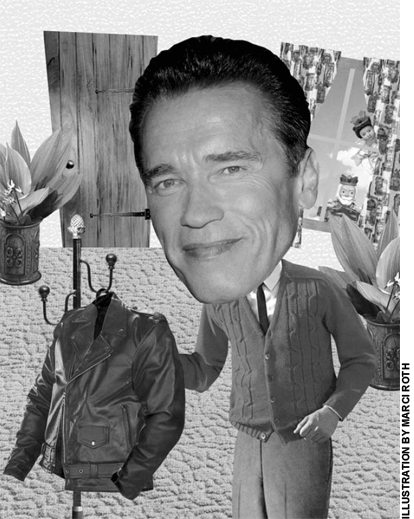 When in 2006 California governor Arnold Schwarzenegger asked a panel of education experts to recommend an overhaul of the state’s troubled public schools, observers hoped the celebrity chief executive was about to bring his unique brand of postpartisan politics to an issue that sorely needed it. Schwarzenegger had built consensus in a fractured legislature on such difficult issues as workers’ compensation, prison reform, and the largest package of public-works bonds in the nation’s history. He was working closely with Democrats on health care. And now he had declared that 2008 would be his “Year of Education Reform.”
When in 2006 California governor Arnold Schwarzenegger asked a panel of education experts to recommend an overhaul of the state’s troubled public schools, observers hoped the celebrity chief executive was about to bring his unique brand of postpartisan politics to an issue that sorely needed it. Schwarzenegger had built consensus in a fractured legislature on such difficult issues as workers’ compensation, prison reform, and the largest package of public-works bonds in the nation’s history. He was working closely with Democrats on health care. And now he had declared that 2008 would be his “Year of Education Reform.”
But that optimism faded when Schwarzenegger, confronting a growing deficit in the state budget, shelved most of the far-reaching recommendations that his own commission sent his way. It would be neither fair nor practical, the governor said in January 2008, to ask the education community to accept a major dose of reform at the same time that he was proposing to cut state spending on the schools.
“We can’t do…all the things that we wanted to do,” Schwarzenegger said in an appearance before the California Newspaper Publishers Association. “It’s just simply because we won’t have the money available. And it is very hard to negotiate and to sit down with the education coalition and to say, ‘Here is what we want you to do; here are the 20 things we want you to do, but we’re going to take 3.5, 4 billion dollars away from you.’ So that doesn’t make any sense.”
Total Recall
Schwarzenegger’s caution undoubtedly grew out of his experience in 2005, when he did try to push education reform and budget cuts at the same time, and failed miserably. But his strategy also reflected the approach he has taken to education policy since he was elected: mostly hands-off. Despite a political persona and personal résumé that suggested the issue would be a perfect one for him, and despite the public’s seeming thirst for new ideas to improve the schools, Schwarzenegger has not made education policy a priority.

Bonnie Reiss, a longtime friend of the governor who served on his staff for two years, advised him on education issues, and was one of his appointees to the state Board of Education, said Schwarzenegger told her and others in his administration why he did not want to get involved in a long, politically difficult effort to overhaul the public schools.
“The recall election was not about public education,” Reiss said, referring to the historic 2003 election in which voters ousted a sitting governor, Gray Davis, and installed Schwarzenegger in his place. “The recall was about the budget, economic issues, energy, businesses fleeing the state. He used to say California was like a patient in triage. First we have to stop the bleeding. Then we have to heal the patient. Arnold felt very strongly that the anger of the voters that created the recall was not about public education. As critical as it was, it was not one of the first things he had to do in triage.”
Like a good physician, Schwarzenegger, at least for his first four years, followed the Hippocratic oath: do no harm. He proposed nothing that would undo the bipartisan momentum California has built on solid academic standards and a testing regimen that tells students, parents, and schools where they stand, in relation not only to the entire state but also schools with similar demographics. And he has vetoed bill after bill sent to him by a legislature that often does the bidding of the state’s powerful teachers unions, which have opposed much of California’s accountability system. The result has been a record best described as a kind of benign support for the status quo. That might not be an entirely bad thing. California’s schools, appear not to be worsening with respect to national trends (see Figure 1), and adding more reforms just for the sake of reform might not necessarily improve them.
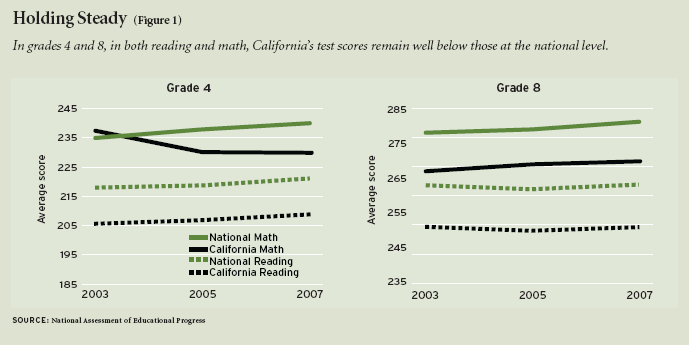
Commando
Ironically, Schwarzenegger when he took office was probably more steeped in education policy than any California governor in a generation. He has four children, for one thing, and while they attended private schools, Schwarzenegger’s kids at least gave him a partial window into a world that was completely unknown, on a personal level, to three of the four governors who had preceded him in the office. He had also sponsored a successful ballot initiative, Proposition 49 in 2002, which set money aside in the state budget for an expansion of afterschool programs. That campaign led him to meet and seek the support of people from across the education community, from teachers to administrators and school board members.
As a candidate in 2003, he criticized the performance of the schools and pledged to restore more control to local districts. Schwarzenegger’s most vivid campaign promise on education policy was to cut through the red tape that bound local districts to the state’s multivolume Education Code. A series of stories in the Sacramento Bee detailed how the legislature and previous governors had created one special program after another, known as “categoricals,” that lived on without much if any assessment of whether they were accomplishing their goals. The programs tied up more than one-third of the education budget, limiting the ability of local trustees and administrators to spend money as they pleased.
A district that didn’t need new textbooks, for example, might still be forced to spend more money on instructional materials, or lose it, because the state had set aside a pot of money for the purchase of new books after it was disclosed that the massive Los Angeles Unified School District had many campuses where the students lacked basic texts. A school that didn’t need any more security measures might add them anyway because the legislature, after the Columbine High School shootings in Colorado, had appropriated another pot of money to be used only for more campus police, cameras, and metal detectors. The state funded at least 20 separate programs for teacher training alone, each with its own set of requirements, objectives, and paperwork—and with little thought put into whether they complemented or duplicated one another.
Soon after taking office, Schwarzenegger proposed a sweeping reform that sought to repeal the statutory mandates for 22 of the special programs and fold the money into general-purpose budgets for districts to spend as they chose. The new governor’s proposal might not have been sexy, but it was sensible, and it was consistent with what he had said during his campaign and with what many education reformers and analysts had been arguing for years. Of course, it also met with opposition from constituencies and legislators with ties to the programs that would no longer be guaranteed a steady stream of revenue, and the proposal soon bogged down in the legislature.
But Schwarzenegger’s aides pressed on. Working closely with then state senator Dede Alpert of San Diego, a veteran legislator who shared the governor’s goals, they eventually settled on a compromise that consolidated 26 programs and $2 billion in funding into block grants covering six broad subject areas. Districts were freed to spend the money within each grant on any of the programs in that subject area or on new priorities consistent with the goals of those programs.
The deal could have been a model for Schwarzenegger to build on. He could have celebrated his success and pushed for more the following year, perhaps exploring the concept of granting broad freedoms over spending, even total flexibility, to districts whose students were meeting state goals. But Schwarzenegger stopped there. According to Reiss, he did not push harder for local control because once he took office he learned how much power the teachers unions held over many local school boards. Cutting the strings from Sacramento, he concluded, would only give the unions more control at the local level.
“It would be nice to think that they make all the right decisions,” Reiss, a liberal Democrat, said, “but with the way the power structure works, that’s not the case.”
Raw Deal
As he began his second year as governor, Schwarzenegger struck a more confrontational pose with the Democrats who controlled the legislature. He proposed a series of policy reforms involving the state’s budget, public employee pensions, the drawing of political district lines, and education. The proposals were not built around any theme other than that they were all things that the majority Democrats in the legislature and their interest-group allies were sure to oppose.
Nowhere was that more true than on education. Schwarzenegger offered two ideas that were neither new nor terribly imaginative. One was to tie teacher pay to performance. The other was to extend the length of time a new teacher would have to work before qualifying for permanent status, or tenure. There was nothing wrong with either idea. But it was difficult to see how either would have transformed the schools. And they certainly didn’t seem to be worth the political risk Schwarzenegger was taking in proposing them.
Indeed, the proposals were the equivalent of a declaration of war on the teachers unions and their membership. The massive California Teachers Association (CTA) and the smaller California Federation of Teachers (CFA) reacted in kind, targeting Schwarzenegger with their invective and their advertising dollars. To make matters worse, the governor unveiled the proposals just as he was also revealing that, in his new budget, he was going to break a promise he had made to the education lobby a year before.
In his first weeks as governor, desperate to try to balance the budget without raising taxes as he had pledged during his campaign, the rookie chief executive met behind closed doors with teachers, administrators, and school board members in search of solutions. In the end, these groups shocked their friends in the legislature by agreeing to a plan that would shave $2 billion from the minimum the state constitution required the state to spend on the schools. In exchange, Schwarzenegger agreed to resume funding the schools at no less than the constitutional minimum one year later.
What he did not fully realize at the time was that his pact would commit him to giving the schools the lion’s share of any new revenue that flowed into the state. As it happened, tax receipts were projected to increase by about $5 billion in 2005–06, Schwarzenegger’s second year as governor. But the terms of his deal with the educators would have forced him to give $4.7 billion of that new money to the schools while cutting health care, social services, prisons, and other programs. It was either that or raise taxes, which Schwarzenegger had said he would not do.
So the governor broke his word and broke his deal. He did propose a $3 billion increase for the schools, enough to keep pace with enrollment growth and inflation. The school community, led by the California Teachers Association, launched a campaign to vilify him. The CTA alone spent more than $50 million to defeat his measures, and the teachers were joined by the other public employee unions. By the time the fight ended in a special election in November 2005, all of Schwarzenegger’s proposals would be defeated and a majority of voters would be saying that they were not inclined to reelect him to a second term the following year. Just 30 percent of Californians said they approved of the way Schwarzenegger was handling the education issue (see Figure 2).
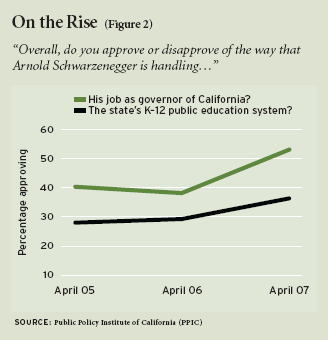
The governor’s problems had a lot to do with substance: the voters did not share his view that bad teachers were at the root of whatever ailed the schools, and they didn’t like the fact that he had broken his word on funding (see Figures 3 and 4).
But Schwarzenegger also had a communications problem. Many of the education policies he would pursue as governor were designed to help close the achievement gap between students from low-income families and those from more affluent circumstances, a goal most voters shared. But he never really tried to pull those policies together into a coherent program that voters could understand and identify with him.
A similar problem had once plagued Schwarzenegger’s image on environmental issues. Although he was pursuing a number of policies that voters, when polled, said they supported, few associated those policies with the governor, and most rated him poorly on the issue. It was not until he embraced the movement to combat global warming with new controls on carbon emissions that voters began to identify him as an environmentalist Republican. But the governor never found a similarly dramatic education policy that could grab the attention of the public, who typically associate school policy with Democrats.
The Kid & I
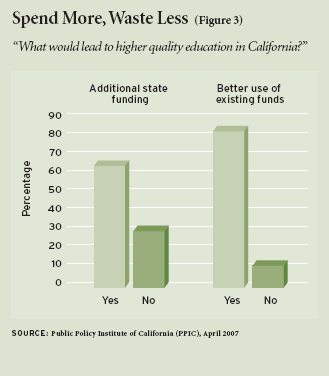
Schwarzenegger’s signature issue could have been the achievement gap. His focus on poor kids began before he became governor, with his sponsorship of Proposition 49 on the 2002 ballot. Although the measure was more about politics than policy—it was designed to raise the Hollywood actor’s stature in advance of a future run for governor—the ballot initiative did reflect Schwarzenegger’s sincere interest in inner-city schools, dozens of which he had toured during work for his nonprofit foundation, the Inner-City Games. The foundation began as an effort to promote afterschool athletics in schools serving primarily underprivileged children. Schwarzenegger expanded the program to include an academic element as well, with tutoring and homework sessions. The measure proposed to set aside hundreds of millions of dollars a year to expand the programs, with first priority for the money going to schools serving disadvantaged pupils. In a national television interview during the campaign, Schwarzenegger spoke of the support he had from his parents as a child in Austria and how it made the difference in his development.
“When I look in those inner-city schools and I see those kids going out after school and not having this kind of supervision, not having this kind of help, not having this kind of love, anyone to help them with their homework, anyone that mentors them and tells them that they’re great, I say to myself those kids will never be ready and have the opportunity to use this land that that they have, the land of opportunity,” Schwarzenegger said. “They will never make it. And so what I promised myself at that point was—is that I’m going to go out and make sure that every child has the same opportunities that I had.”
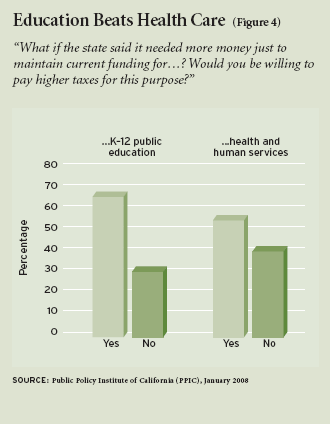
Schwarzenegger’s measure won the support of educators, law enforcement, business groups, and lawmakers from both parties. It passed easily, with 57 percent of the vote, in the same election at which voters returned then governor Gray Davis to office for a second term.
But Proposition 49 was flawed. It was ballot-box budgeting at its worst, setting a narrow priority for state spending that would tie the hands of legislators, future governors, and educators, the very kind of “auto-pilot” spending Schwarzenegger would later decry. But it did reflect his desire to improve conditions for poor students. And as governor, Schwarzenegger would continue that same pattern: pursuing a variety of well-intended if imperfect policy approaches meant to help underprivileged children.
One of his first acts as chief executive was to settle a lawsuit filed against the state by the American Civil Liberties Union (ACLU) on behalf of students in 18 districts around California, most in poor communities. Students in those schools, the lawsuit alleged, were being denied equal opportunity because they lacked qualified teachers, modern textbooks, sanitary bathrooms, heat, and air-conditioning. The state, under Governor Davis, had fought the lawsuit, using an expensive private law firm to argue that the problems, if they existed at all, were the responsibility of local school districts.
Schwarzenegger held that those districts, even if they were responsible, were incompetent. So he told his staff to settle the lawsuit, and he was personally involved in the negotiations, some of which he convened in his famous “smoking tent” in the inner courtyard of his Capitol office suite. After months of talks, the governor agreed to a solution that would pump $1 billion into schools in poor neighborhoods. The settlement included standards for the schools to meet and empowered county superintendents to enforce the edict and monitor compliance. The ACLU, in a bit of hyperbole, compared the deal to Brown v. Board of Education, the landmark U.S. Supreme Court case that overturned the doctrine of “separate but equal.”
Schwarzenegger also stepped into a dispute over the future of the state’s largest school district, Los Angeles Unified, siding with Los Angeles mayor Antonio Villaraigosa against the district’s board and the teachers union (see “Power Struggle in Los Angeles,” forum, Summer 2007). Arguing that the district’s poor and largely Latino student body was suffering from neglect, Villaraigosa wanted to take over the entire district, a move the governor supported. But the mayor could not win approval of that idea in the legislature, and he and Schwarzenegger settled for a compromise that rather than increasing accountability would have defused it further, dividing responsibility for the district among the board, the superintendent, and the mayors. Schwarzenegger announced early on that he would sign any bill Villaraigosa could get to his desk, and that’s exactly what he did, with great fanfare. But the courts struck down the new law as a violation of a state constitutional provision prohibiting anyone but a locally elected school board from running the schools.
Schwarzenegger also made a big rhetorical commitment to vocational education, now called career technical education, reflecting his belief that the schools were shortchanging students who either would not go on to college or would begin college but never finish. Schwarzenegger added $20 million to the program’s budget in 2006—once again making an exception to his call for more local control—and proposed a bigger increase in 2007. His school construction bond, which voters approved in 2006, included $500 million for new and expanded buildings for career technical education, an unprecedented level of funding.
Preschool was another issue where Schwarzenegger said he preferred to focus scarce resources on problems afflicting disadvantaged students. When Hollywood director Rob Reiner proposed a ballot initiative (Proposition 82 in 2006) calling for an income tax increase to make preschool universal and free for all of the state’s four-year-olds, the governor sided with opponents, who noted that the measure would use precious potential tax revenue to pay for a service that a majority of the state’s youngsters already received. The initiative would have given free preschool to the children of middle-income and wealthy parents and squeezed out a flourishing network of private preschools in favor of the new publicly financed system. During the campaign, Schwarzenegger pledged to increase the state’s commitment to preschool for poor children, and he later added $100 million to the budget over two years to open more slots for four-year-olds from low-income families. In the end, the ballot initiative was rejected by the voters.
Still, Schwarzenegger has not left much of a mark on education policy. His biggest impact might have come from playing defense. He has vetoed a number of bills that would have undercut California’s much-lauded system of standards, testing, and accountability. He rejected a measure that would have exempted the state’s growing Latino population from testing in English until they had been in California’s schools for three years, a proposal he said would give the schools less incentive to teach English quickly. And he sent back a proposed law that would have allowed schools to use “alternative assessments” for students who had failed the state’s high school exit exam.
State senator Darrell Steinberg, a Sacramento Democrat who has focused on reducing the number of high school dropouts in California, said he thinks Schwarzenegger sincerely wants to improve the lot of poor children. “I think he is driven by the reality that too many kids are falling through the cracks,” Steinberg said in an interview. “I think he recognizes that this issue of the forgotten kid is in many respects a civil rights issue, an equal opportunity issue, and an economic development issue. His heart is in the right place. The question is whether he will have the desire or the ability to make education reform on finances and policy a focus and a priority of his administration.”
The Running Man
As Schwarzenegger ran for reelection in 2006, he deflected questions about his education policies by commissioning, with the leaders of the state legislature, an independent research project to recommend funding levels and reforms needed to provide a quality education for every child in California. That project, overseen by Stanford University researchers, produced a series of studies concluding that the schools needed more money but that, without significant reforms, no amount of money would produce much change. Among the policy changes the researchers recommended: the state should eliminate categorical programs and devolve more authority to school districts and even school sites, giving principals the right to hire and fire their own staffs.
A separate panel the governor appointed to review the research recommended a series of far-reaching measures to put the Stanford group’s broad conclusions into practice:
• Make teaching a true profession—with training and pay to match—while also holding teachers more accountable for their results in the classroom.
• Invest more money in education, give districts and even individual schools more control over the money while directing funds to students who need the most help, and eliminate almost all categorical mandates.
• Empower county superintendents to enforce accountability rules, make the independently elected state superintendent of public instruction a sort of “inspector general” for school quality, place state education policy under the governor, and make the state board of education advisory to the governor.
• Create a comprehensive student-data system that tracks individual student progress from preschool to the workforce.
Instead of embracing those ideas and running with them, Schwarzenegger backed away in January 2008, citing the enormity of the state’s budget crisis. Instead, he recommended new state interventions in 98 districts that were failing to meet the standards of the federal No Child Left Behind law; waivers from state rules and regulations for high-performing districts; and an improved data system to guide state and local decisionmaking in the future. He also pledged to lead a series of public hearings on the issue around the state in 2008.
His proposals for 2008 were, then, a microcosm of his entire career as governor. They were driven by good instincts and informed by good advice, but they were piecemeal rather than comprehensive, and they were unlikely to engage the public in a way that could build widespread support. Anyone hoping to see him one day create the broad consensus necessary for fundamental education reform will have to wait at least another year.
Daniel Weintraub is the public affairs columnist for the opinion pages of the Sacramento Bee. He is the author of Party of One: Arnold Schwarzenegger and the Rise of the Independent Voter.


